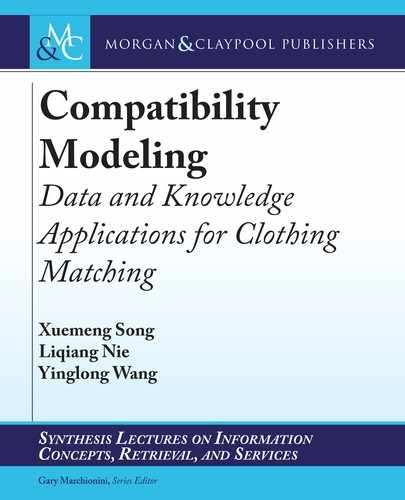6.3. METHODOLOGY 67
In light of this, we measure the user preference toward a bottom for a given to-be-matched
top based on both the general compatibility modeling and the personal preference modeling.
Formally, we have
8
ˆ
<
ˆ
:
p
m
ij
D s
ij
C .1 / c
mj
;
s
ij
D G
t
i
; b
j
j‚
G
;
c
mj
D P
u
m
; b
j
j‚
P
;
(6.2)
where G and P correspond to the general compatibility modeling and personal preference mod-
eling networks, respectively. ‚
G
and ‚
P
are the corresponding model parameters. s
ij
denotes
the general compatibility between the top t
i
and bottom b
j
, while c
mj
represents the personal
preference of user u
m
toward the bottom b
j
. is the non-negative tradeoff parameter to control
the relative importance of both components.
6.3.2 GENERAL COMPATIBILITY MODELING
To measure the general compatibility between fashion items, similar to [108], we aim to seek
the latent space where the compatibility between complementary fashion items can be well cap-
tured by the distance between their latent representations. In particular, we adopt the MLP
again, owing to its superior performance in various representation learning tasks [12, 74, 123].
To comprehensively characterize each fashion item and enhance the general compatibility mod-
eling, we utilize both (i.e., the visual and contextual) modality signals. Here, we take the visual
representation learning of tops as an example. Given the i-th top v
t
i
, we have
8
<
:
h
t
i1
D s
W
t
1
v
t
i
C b
t
1
;
h
t
ik
D s
W
t
k
h
t
i.k1/
C b
t
k
; k D 2; : : : ; K;
(6.3)
where h
t
ik
denotes the hidden representation, W
t
k
and b
t
k
, k D 1; : : : ; K, are the weight matrices
and biases, respectively. s W R 7! R is the nonlinear activation function applied element wise.
2
We treat the output of the K-th layer as the latent visual embedding for the top, i.e., Qv
t
i
D h
t
iK
2
R
D
v0
, where D
v0
denotes the dimensionality of the latent compatibility space.
In the similar manner, we can also derive the latent contextual embedding for the top
t
i
, and the visual and contextual embeddings for the bottom b
j
as Qc
t
i
, Qv
b
j
, and Qc
b
j
, respectively.
ereafter, to comprehensively measure the general compatibility, we define,
s
ij
D
Qv
t
i
T
Qv
b
j
C .1 /
Qc
t
i
T
Qc
b
j
; (6.4)
where is the non-negative trade-off parameter, calibrating the relative importance of the
modalities. s
ij
denotes the general compatibility between the top t
i
and bottom b
j
.
2
In this work, we use the sigmoid function s.x/ D 1=.1 C e
x
/.
..................Content has been hidden....................
You can't read the all page of ebook, please click here login for view all page.
